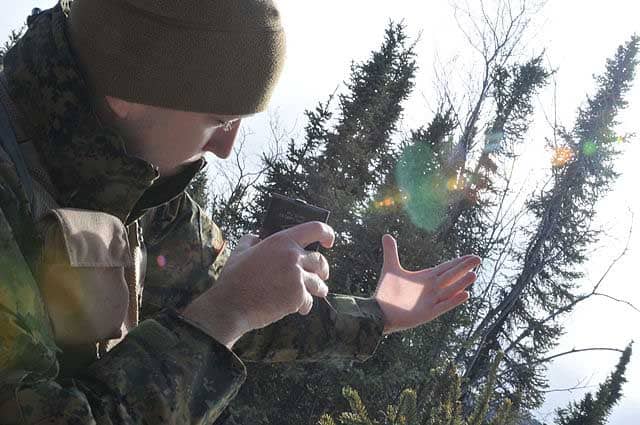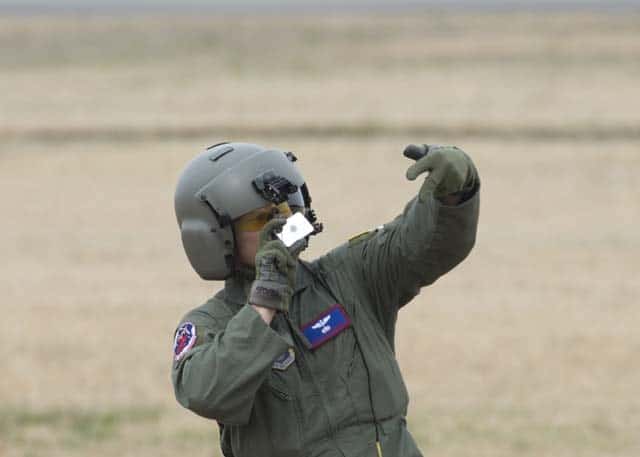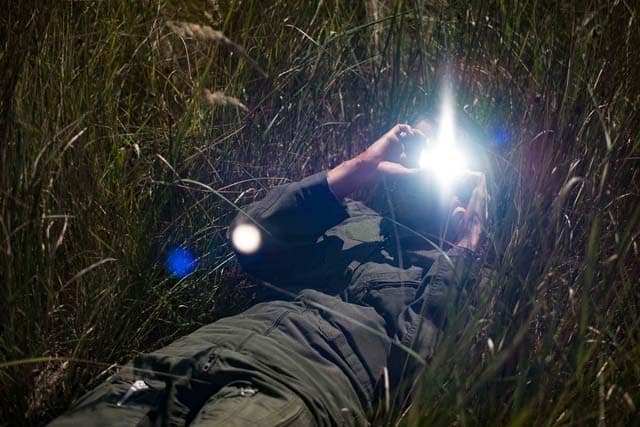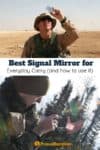If you are lost in the wilderness or out at sea, it is incredibly hard to be seen from above.
Any distress signal you send greatly improves the chance you will be rescued. One of the simplest yet most effective ways of sending a distress signal is to use a signal mirror.
Best Signal Mirrors
While anything reflective can work as a signal mirror, improvised signal mirrors can be difficult to aim. Modern signal mirrors are made with a special retroreflector to help with aiming.
The retroreflector looks like a mesh screen. When you look through the mesh, you will be able to see the mirror’s beam of light as a bright spot. This makes it much easier to aim the light at your target.
To choose a good signal mirror, look for:
Size: Larger signal mirrors aren’t necessarily easier to aim. Instead, look for one that you can comfortably hold in your hands and is practical to carry (such as one that will fit in your wallet or first aid kit). Otherwise, you won’t have it with you when you need it.
Retroreflective viewing hole: Not all products have retroreflective material in the viewing hole. Without this, you won’t see the “fireball” effect in the viewing hole.
Floats: Some better signal mirrors will float. This feature is a must-have on mirrors in boat and airplane survival kits. The floating feature isn’t as important if it’s in your wallet as part of an EDC kit. *You can always attach a floating bobber to a signal mirror’s lanyard hole to make it float.
Material: Plastic is generally better than glass because it won’t break as easily. It also doesn’t scratch as easily as metal signal mirrors. Modern signal mirrors use highly reflective plastic. However, many prefer glass signal mirrors because they generally reflect longer distances. Stainless steel also reflects further than most plastic signal mirrors but scratches easily.
 UST StarFlash Floating Signal Mirror
UST StarFlash Floating Signal Mirror
This signal mirror is easy to aim and works well. It also floats, so it is suitable for marine use.
The StarFlash has an opaque mesh, making it more challenging to see the light when aiming.
Also, note that there is a larger StarFlash model. However, it doesn’t float—only this smaller signal mirror floats.
Specs
- Size: 2×3″
- Weight: 0.4oz
- Material: Lexan polycarbonate plastic
- Floats: Yes
- Lanyard hole: Yes
 MIL-M-18371E Emergency Signalling Mirror
MIL-M-18371E Emergency Signalling Mirror
This signal mirror is made by S.I. Howard Glass Company is in the USA and is a military-approved item. There are two sizes: 2×3″ (Mark 2) and 3×5″ (Mark 3).
The mirror material means it will reflect for further distances. But, because it is made of glass, the signal mirror could break and will not float.
However, it is very tough and won’t break or scratch easily. You still may want to carry it in bubble wrap, though. The lanyard hole means you can attach a floatation bobber to it.
Specs
- Size: 2×3” and 3×5”
- Weight: 2oz and 5oz
- Material: Glass
- Advertised visibility: Up to 100 miles
- Made in: USA
- Floats: No
- Lanyard hole: Yes
 Best Glide ASE Compact
Best Glide ASE Compact
Best Glide ASE also makes glass signal mirrors. However, I don’t think they are better than the 5col signal mirror, so I didn’t include it here.
This small signal mirror does have a hole for aiming, but there is no retroreflective mesh for spotting the light beam. However, this signal mirror is worth including on the list because it is tiny.
If you don’t have it with you, it won’t do you any good. At only 2 inches long, you can easily carry it in your wallet.
So, if you realistically aren’t going to carry around one of the other slightly larger and thicker signal mirrors, get this one to put in your wallet as part of your EDC.
Specs
- Size: 2×1.5″
- Weight: Under 1oz
- Material: Stainless steel
- Floats: No
- Lanyard hole: Yes
Are Signal Mirrors Effective?
The U.S. Air Force’s survival handbook calls them
“probably the most underrated signaling device found in the survival kit.”
Search and rescue officials like Chris Sharpe (who has flown over 6,000 rescue operations) calls mirrors
“simply the best signaling device ever.”
Numerous cases have occurred of people being rescued because they used signal mirrors.
For example, there were the 4 people floating in life vests for two nights in the waters off the Bahamas. Even though several boats and planes went by, the victims weren’t noticed. It wasn’t until they used a shiny credit card to send a signal that they were rescued.
In another case, a man was injured during a rafting trip. A member of his group used a signal mirror to send a Morse code message for help. They were luckier: It only took a few minutes for a jet airliner flying overhead at 35,000 feet to notice the signal and radio for assistance.
How Far Can Signal Mirrors Be Seen?

There’s a lot of conflicting information about this. Reports say mirrors can send signals anywhere from 10 to 50 miles away on a clear day. Signal mirrors still work on overcast days, but the range is much shorter.
When sending signals upwards, the range is much further. The signal can go up to 10 miles (52,800 feet) in the air. Some claim that signal mirrors can transmit 100 miles away.
Other Benefits
In many situations, smoke, fire, or flashlight signals are probably the best way to call for help.
However, there are many benefits of a signal mirror:
- No fire required: Signal mirrors are good when you can’t light a fire, such as on a boat when you have no firewood or don’t know how to start a fire without matches.
- Works without electricity: Flashlights will eventually run out of batteries. Signal mirrors only require some sunlight.
- Small and compact: Unlike flares and flashlights, it is easy to carry in your pocket, wallet, or backpack.
- Can easily be made: Professional signal mirrors work best, but you can also make one out of credit cards, tinfoil, or anything else reflective.
Downsides
While many survivalists are quick to tout the benefits of carrying a signal mirror, they are far from perfect.
Some of the issues are:
- Require Skill to Use: Aiming a signal mirror accurately takes a lot of practice. However, newer signal mirrors with aiming devices do make this easier.
- Active Signaling: Distress signals can be broken down into “passive” and “active.” Passive signals, such as an SOS sign, don’t require any work once set up. Active signals have to be constantly done, which means you aren’t able to do other survival tasks. Signal mirrors are active.
- Don’t work at night: It is possible to reflect the light of a full moon, but in general, you need sunlight to use a signal mirror. They work when overcast, but the light won’t be as visible or have much range.
- Don’t work well in thick forests: In forests or other places where there are a lot of obstacles in your path, it might not be possible to send a distress signal with a mirror. The light will be blocked.
- Could Cause an Accident: The light from the signal mirror could go into someone’s eyes and temporarily blind them. This could result in an accident. It is important that you stop aiming the signal mirror at planes once you have been spotted.
How to Use a Signal Mirror
Regardless of what type of signal mirror you use, you’ll want to aim the light in the direction of possible rescuers.
Even if no rescuers are in sight, you can still signal. Sweep the light across the horizon or wherever rescuers might see you. The flash of light from a signal mirror can be seen miles away.
Instructions for a Signal Mirror with Sighting Hole

- Hold the mirror at the edges. You don’t want your fingers to block any of the reflecting surface.
- Facing the sun, reflect the light from the mirror onto your hand or another nearby surface.
- Slowly bring the mirror up to eye level so you can look through the sighting hole. The bright spot within the hole is the aiming indicator.
- Keep the mirror close to your eye and slowly move it so the bright light hits your target. You will need both the target and light to remain within the mesh area. The light will only be visible in the mesh and not the hole in the middle of the mesh.
- When the bright spot meets the target, you will be flashing the target. You only need to move the mirror slightly to create a flash.
- Continue flashing the target by moving the signal mirror left-right, not up-down.
Instructions for an Improvised Signal Mirror:
- Hold the mirror just below eye level. Make sure your fingers are at the edge of the mirror.
- With your other hand, hold up two fingers and make a V with them. Your target should be visible between the V.
- Angle the mirror so the sun reflects off it and hits the V you made with your fingers. This is how you can be sure that the reflection is going through your fingers and towards your target.
- Move the mirror up and down so it will flash your target.
- Keep your eye, the top of the mirror, and your V in a straight line.
If the sun is hitting your back, but you need to signal in front of you, then you will need to adjust your position:

- Lay on the ground.
- Extend your arm in front of you towards your target. Make a V with your fingers and ensure your target is visible within the V.
- Grasp the signal mirror and hold it over your head on the ground.
- Adjust the angle of the mirror so it reflects on the V you made.
Tips:
Since using a signal mirror takes a lot of practice, it is best to practice before you need it. You can have some fun by going into the woods or your backyard and playing with it.
Or, if you are ever in a situation where you will need to be rescued, start practicing with the signal mirror before you see any rescue planes. That way, when a plane does fly over, you will be ready to signal to it with the mirror.
Remember to practice only on inanimate objects. The light from signal mirrors can temporarily blind people and result in accidents.



Hi Folks. 1st…as far as survival locations go… I live in paradise… Northeast USA! Mixed pine / hardwoods, natural water sources, hills & valleys, lots of small lakes to fish, etc. SPOILED ROTTEN!
All 4 of my signal mirrors are 2×3, s.i. Howard, slid in
felt pouches, enclosed in Altoid tins with 6 pcs of UNCHARED cotton / 3″ Ferro rod / striker & carried in a compass pouch. ( just part of EDCs & go kits)